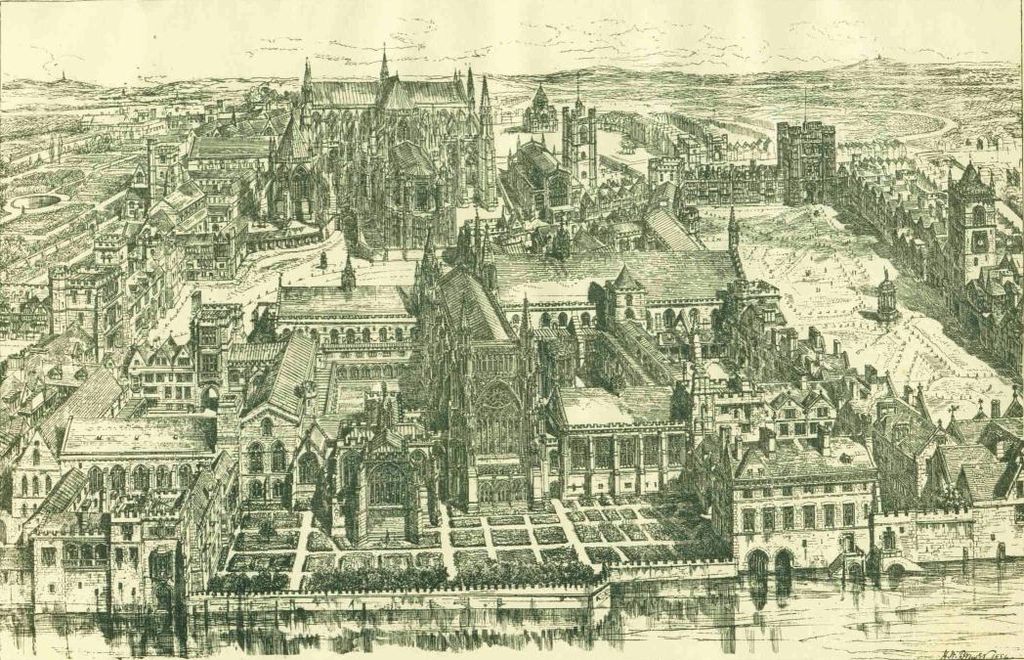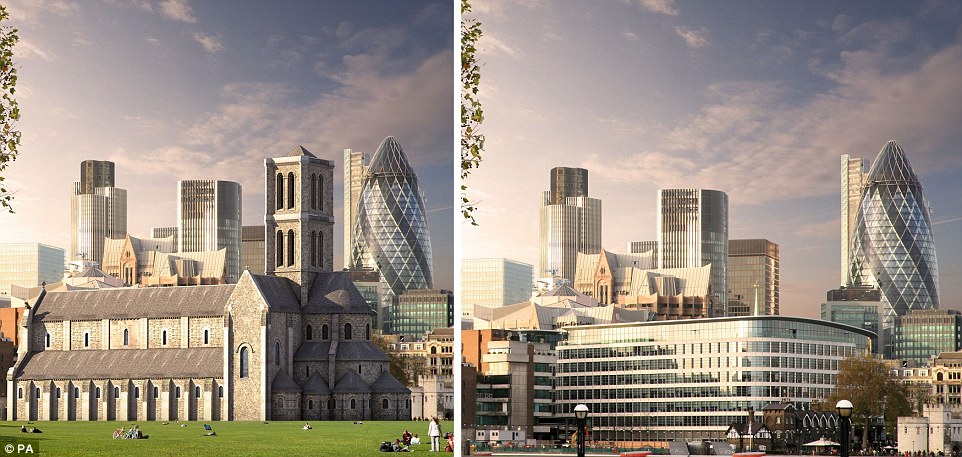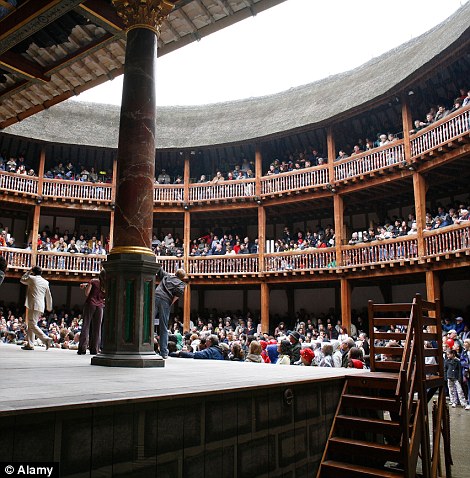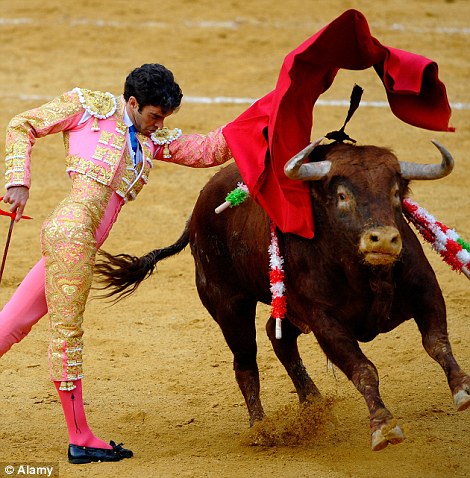These extraordinary photographs show how Britain might be very different if Guy Fawkes and his gang had succeeded in blowing up the Houses of Parliament.
The computer-generated images depict an imaginary Catholic London, with Parliament replaced by a princess's castle and a monastery standing in what is now the City.
If the Gunpowder Plot had succeeded despite the efforts of spies such as Robert Cecil, James I would have been replaced on the throne by his young Catholic daughter Elizabeth.
And in place of the destroyed Houses of Parliament, the young princess, who was known to be 'spoilt and have extravagant taste', would probably have built an opulent castle.
Experts also suggest that if history had gone differently, Brits could be enjoying paella instead of fish and chips, and flock to bull fights instead of Shakespeare's plays.
Is this what the Palace of Westminster would look like if the gunpowder plot had succeeded? Britain as we know it today would not exist without the shadowy espionage of 'the James Bonds of yesteryear'
Amazing artist's impressions show how London might look if Britain had not turned away from the Catholic church
They show an opulent castle in Westminster, a monastery in the City and a castle on the South Bank
The images were created to highlight the impact on the country from spies throughout British history
By Hugo Gye for MailOnline
16 October 2015
Daily Mail
These extraordinary photographs show how Britain might be very different if Guy Fawkes and his gang had succeeded in blowing up the Houses of Parliament.
The computer-generated images depict an imaginary Catholic London, with Parliament replaced by a princess's castle and a monastery standing in what is now the City.
Experts also suggest that if history had gone differently, Brits could be enjoying paella instead of fish and chips, and flock to bull fights instead of Shakespeare's plays.

Contrast: This image shows how the Palace of Westminster could have been replaced by a French-style castle if the Gunpowder Plot had been carried out

Opulent: The artist's impression show what a palace for James I's Catholic daughter Elizabeth could have looked like

How the Palace of Westminster, which is home to both Houses of Parliament, looked at the time of the Gunpowder Plot in 1605

Parliament was destroyed by fire in 1834, leading to the construction of the present building
The images were created to mark the launch of a new TV programme which emphasises the importance of spies in shaping British history.
Historians suggested that the network of spies created by Thomas Cromwell had helped steer Henry VIII through his marriage troubles and the subsequent break with Rome, which led to the establishment of the Church of England.
If he had failed, the king might never have brought about the dissolution of the monasteries, and London's skyline would be dominated by grand ecclesiastical structures.
The plan to assassinate Queen Elizabeth I, and put Mary, Queen of Scots on the throne of England was foiled by fierce Protestant Francis Walsingham and his team of spies.

City: A monastery could have stood in place of London's financial district if it were not for Thomas Cromwell bringing about the end of the Catholic church in Britain

Scottish: Castles inspired by the design of Edinburgh Castle and Stirling Castle might have been built on the South Bank if Mary Queen of Scots had come to the throne
Had the plot been carried out and Mary became the Queen of England she would have built Scottish-style castles, in keeping with the look of Edinburgh or Sterling Castle, along the banks of the River Thames.
If the Gunpowder Plot had succeeded despite the efforts of spies such as Robert Cecil, James I would have been replaced on the throne by his young Catholic daughter Elizabeth.
And in place of the destroyed Houses of Parliament, the young princess, who was known to be 'spoilt and have extravagant taste', would probably have built an opulent castle.
Historians also revealed a different result in the Battle of Trafalgar could have seen Nelson's Column and the Wellington Arch replaced with buildings in Napoleon's honour, while an English loss in the Spanish Armada could have bought England under Spanish rule.


Transformed: High culture in Britain could have changed from Shakespeare plays (Globe Theatre, London, top) to bull fighting
This would have transformed the country's cultures and cuisine, with our beloved fish and chips replaced by paella and bull fights rising in popularity at the expense of the theatrical tradition.
Dr Tracy Borman of Historic Royal Palaces, who put together the report for the show History's Ultimate Spies on Yesterday, said: 'In the Tudor and Stuart periods, England was under tremendous pressure from the Catholicism of mainland Europe, and was a country in transition.
'These religious tensions birthed scores of assassination attempts from within and declarations of war from elsewhere, and the role of Britain's spies should not be underplayed when discussing how history eventually unravelled.
'History's Ultimate Spies shows just how integral spies were to both domestic affairs and foreign wars, and the huge repercussions their work had for our country and the City of London alike.'
Adrian Wills, of Yesterday, added: 'Londoners are rightly proud of our city's most famous landmarks, but it is staggering just how different the capital's skyline might have looked had it not been for the work of the James Bonds and 'M' of yesteryear.'
History's Ultimate Spies launches on Yesterday at 10pm tonight.
The computer-generated images depict an imaginary Catholic London, with Parliament replaced by a princess's castle and a monastery standing in what is now the City.
If the Gunpowder Plot had succeeded despite the efforts of spies such as Robert Cecil, James I would have been replaced on the throne by his young Catholic daughter Elizabeth.
And in place of the destroyed Houses of Parliament, the young princess, who was known to be 'spoilt and have extravagant taste', would probably have built an opulent castle.
Experts also suggest that if history had gone differently, Brits could be enjoying paella instead of fish and chips, and flock to bull fights instead of Shakespeare's plays.
Is this what the Palace of Westminster would look like if the gunpowder plot had succeeded? Britain as we know it today would not exist without the shadowy espionage of 'the James Bonds of yesteryear'
Amazing artist's impressions show how London might look if Britain had not turned away from the Catholic church
They show an opulent castle in Westminster, a monastery in the City and a castle on the South Bank
The images were created to highlight the impact on the country from spies throughout British history
By Hugo Gye for MailOnline
16 October 2015
Daily Mail
These extraordinary photographs show how Britain might be very different if Guy Fawkes and his gang had succeeded in blowing up the Houses of Parliament.
The computer-generated images depict an imaginary Catholic London, with Parliament replaced by a princess's castle and a monastery standing in what is now the City.
Experts also suggest that if history had gone differently, Brits could be enjoying paella instead of fish and chips, and flock to bull fights instead of Shakespeare's plays.

Contrast: This image shows how the Palace of Westminster could have been replaced by a French-style castle if the Gunpowder Plot had been carried out

Opulent: The artist's impression show what a palace for James I's Catholic daughter Elizabeth could have looked like

How the Palace of Westminster, which is home to both Houses of Parliament, looked at the time of the Gunpowder Plot in 1605

Parliament was destroyed by fire in 1834, leading to the construction of the present building
The images were created to mark the launch of a new TV programme which emphasises the importance of spies in shaping British history.
Historians suggested that the network of spies created by Thomas Cromwell had helped steer Henry VIII through his marriage troubles and the subsequent break with Rome, which led to the establishment of the Church of England.
If he had failed, the king might never have brought about the dissolution of the monasteries, and London's skyline would be dominated by grand ecclesiastical structures.
The plan to assassinate Queen Elizabeth I, and put Mary, Queen of Scots on the throne of England was foiled by fierce Protestant Francis Walsingham and his team of spies.

City: A monastery could have stood in place of London's financial district if it were not for Thomas Cromwell bringing about the end of the Catholic church in Britain

Scottish: Castles inspired by the design of Edinburgh Castle and Stirling Castle might have been built on the South Bank if Mary Queen of Scots had come to the throne
Had the plot been carried out and Mary became the Queen of England she would have built Scottish-style castles, in keeping with the look of Edinburgh or Sterling Castle, along the banks of the River Thames.
If the Gunpowder Plot had succeeded despite the efforts of spies such as Robert Cecil, James I would have been replaced on the throne by his young Catholic daughter Elizabeth.
And in place of the destroyed Houses of Parliament, the young princess, who was known to be 'spoilt and have extravagant taste', would probably have built an opulent castle.
Historians also revealed a different result in the Battle of Trafalgar could have seen Nelson's Column and the Wellington Arch replaced with buildings in Napoleon's honour, while an English loss in the Spanish Armada could have bought England under Spanish rule.


Transformed: High culture in Britain could have changed from Shakespeare plays (Globe Theatre, London, top) to bull fighting
This would have transformed the country's cultures and cuisine, with our beloved fish and chips replaced by paella and bull fights rising in popularity at the expense of the theatrical tradition.
Dr Tracy Borman of Historic Royal Palaces, who put together the report for the show History's Ultimate Spies on Yesterday, said: 'In the Tudor and Stuart periods, England was under tremendous pressure from the Catholicism of mainland Europe, and was a country in transition.
'These religious tensions birthed scores of assassination attempts from within and declarations of war from elsewhere, and the role of Britain's spies should not be underplayed when discussing how history eventually unravelled.
'History's Ultimate Spies shows just how integral spies were to both domestic affairs and foreign wars, and the huge repercussions their work had for our country and the City of London alike.'
Adrian Wills, of Yesterday, added: 'Londoners are rightly proud of our city's most famous landmarks, but it is staggering just how different the capital's skyline might have looked had it not been for the work of the James Bonds and 'M' of yesteryear.'
History's Ultimate Spies launches on Yesterday at 10pm tonight.
Last edited: